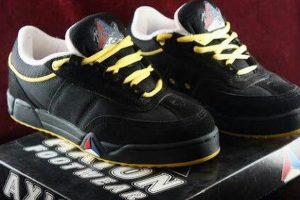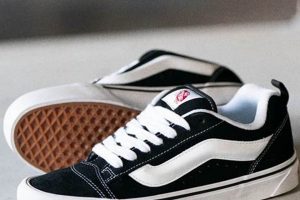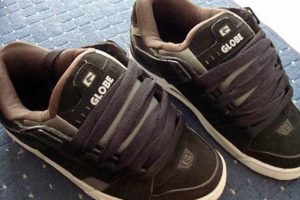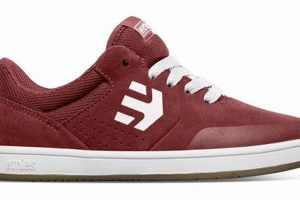Footwear designed specifically for skateboarding often incorporates features that enhance performance and durability. These characteristics typically include a reinforced upper, a vulcanized rubber outsole for grip and board feel, and cushioning to absorb impact during landings. Many models also feature specific tread patterns optimized for skateboarding maneuvers.
The design considerations prioritized in this type of shoe offer substantial advantages to skateboarders. The robust construction withstands the abrasive forces encountered during tricks, extending the lifespan of the product. The enhanced grip facilitates better board control, contributing to improved performance and safety. Historically, certain brands have become synonymous with skateboarding due to their commitment to these performance-enhancing design principles and their long-standing support of the skateboarding community.
Therefore, subsequent sections will delve into the specific materials, construction techniques, and technological advancements that contribute to the functionality and longevity observed in purpose-built skateboarding footwear. Further examination will also explore how these elements translate into tangible benefits for the user, influencing factors such as board feel, impact absorption, and overall comfort during skateboarding activities.
Optimizing Performance with Skateboarding Footwear
The following guidelines address key considerations for maximizing the lifespan and utility of skateboarding-specific shoes.
Tip 1: Reinforce High-Wear Areas: Apply shoe glue or specialized reinforcement patches to areas prone to abrasion, such as the toe box and ollie zone. This preventive measure can significantly extend the shoe’s usable life.
Tip 2: Utilize Proper Lacing Techniques: Employ lacing patterns that minimize lace exposure in high-friction areas. Consider using recessed or reinforced eyelets to prevent premature lace failure.
Tip 3: Rotate Footwear Regularly: If skateboarding frequently, alternate between multiple pairs of shoes. This allows each pair to dry thoroughly between sessions, reducing moisture-related degradation and preserving structural integrity.
Tip 4: Clean Shoes Appropriately: Remove dirt and debris regularly with a brush or damp cloth. Avoid harsh detergents or excessive water exposure, as these can damage the materials.
Tip 5: Consider Insole Replacement: Replace insoles periodically to maintain optimal cushioning and support. Aftermarket insoles designed for skateboarding can provide enhanced impact absorption and stability.
Tip 6: Monitor Sole Wear: Inspect the sole regularly for signs of wear and tear, particularly in high-contact areas. Promptly address sole damage with appropriate repair methods to prevent further degradation.
Tip 7: Store Shoes Properly: Store shoes in a cool, dry place away from direct sunlight to prevent material degradation. Use shoe trees or stuffing to maintain their shape and prevent creasing.
Adhering to these guidelines will promote the longevity and performance of skateboarding footwear, resulting in a more cost-effective and enjoyable skateboarding experience.
The subsequent section will summarize the critical aspects of selecting appropriate skateboarding shoes based on individual needs and preferences.
1. Durability
Durability constitutes a paramount attribute in skateboarding footwear. The inherent demands of skateboarding place significant stress on shoes, necessitating robust construction and resilient materials.
- Reinforced Upper Construction
The upper portion of skateboarding shoes often incorporates multiple layers of durable materials, such as suede, leather, or canvas, reinforced with stitching and overlays. This construction method mitigates wear and tear from abrasive contact with the skateboard, extending the lifespan of the shoe.
- Vulcanized Rubber Outsole
Vulcanized rubber outsoles provide superior grip and board feel. The vulcanization process bonds the rubber to the upper, creating a durable and flexible connection that withstands the forces generated during skateboarding maneuvers. Moreover, specific tread patterns enhance traction and control.
- Reinforced Ollie Patch
The ollie area, located on the lateral side of the shoe, experiences significant abrasion from ollies and other flip tricks. A reinforced ollie patch, typically constructed from extra layers of durable material, provides added protection and prevents premature wear in this critical area.
- Durable Stitching
Stitching plays a crucial role in holding the shoe’s components together. High-quality stitching, utilizing durable threads and reinforced seams, ensures that the shoe remains intact under the stresses of skateboarding. Double or triple stitching in high-stress areas further enhances durability.
The combination of reinforced uppers, vulcanized rubber outsoles, reinforced ollie patches, and durable stitching contributes significantly to the overall durability of skateboarding shoes. These construction elements are integral to withstanding the rigors of skateboarding, ensuring a prolonged lifespan and enhanced performance.
2. Board Feel
Board feel represents a critical attribute of skateboarding footwear, influencing a skater’s ability to perceive and control the skateboard. This tactile feedback allows for precise adjustments and maneuvers, contributing to enhanced performance and board control. The design and construction of skateboarding shoes significantly impact the degree of board feel experienced by the skater.
- Sole Thickness and Composition
Thinner soles, particularly those constructed from vulcanized rubber, generally provide superior board feel. The reduced material between the skater’s foot and the board allows for a more direct transmission of vibrations and subtle changes in surface texture. Conversely, thicker soles, while offering greater impact absorption, tend to dampen these sensations, potentially reducing board feel.
- Outsole Flexibility
The flexibility of the outsole also plays a crucial role. A more flexible outsole allows the shoe to conform to the concave shape of the skateboard deck, enhancing contact and providing a more nuanced understanding of the board’s position. Stiff outsoles can hinder this conformity, limiting board feel and potentially affecting control.
- Insole Design
While insoles primarily contribute to cushioning and impact absorption, their design can also influence board feel. Low-profile insoles with minimal padding maintain a closer connection between the foot and the sole, preserving tactile feedback. Conversely, thicker or gel-based insoles can insulate the foot from the board, diminishing board feel.
- Upper Construction and Materials
The upper construction and materials also contribute indirectly to board feel. A snug-fitting upper made from flexible materials allows the foot to move naturally within the shoe, enhancing proprioception and awareness of the board’s movement. Stiff or bulky uppers can restrict movement and reduce sensitivity.
The optimization of board feel in skateboarding footwear involves a careful balance between tactile feedback, cushioning, and support. Manufacturers often experiment with different sole thicknesses, rubber compounds, and insole designs to achieve the desired level of board feel, catering to the preferences of diverse skateboarding styles and disciplines. Prioritizing board feel can lead to greater board control and improved skateboarding performance.
3. Grip
Grip, as it relates to skateboarding shoes, represents the coefficient of friction between the outsole of the shoe and the surface of the skateboard. For skateboarding footwear, including those manufactured by Vans, this characteristic is paramount for maintaining board control and executing maneuvers with precision. Insufficient grip directly correlates to an increased likelihood of slippage, resulting in missed tricks, compromised stability, and potential injury. The vulcanized rubber outsole, a hallmark of classic Vans skateboarding shoes, is specifically engineered to maximize this coefficient of friction. The unique formulation of the rubber compound, in conjunction with tread patterns designed to interlock with the grip tape on a skateboard, creates a secure connection. Consider, for example, the execution of a kickflip. A skater relies entirely on the grip provided by their shoes to maintain contact with the board throughout the rotation, allowing for a controlled landing. Without adequate grip, the board would slip away, rendering the trick impossible.
The specific tread patterns employed in Vans skateboarding shoes further enhance grip performance. These patterns, often featuring a waffle or diamond-shaped design, increase the surface area in contact with the grip tape. This maximized contact area generates a stronger adhesive force, minimizing the potential for slippage. Furthermore, the geometry of the tread patterns allows for the expulsion of debris, such as dirt and small pebbles, which can compromise grip effectiveness. The effectiveness of a shoe’s grip is not merely a theoretical concept; it is a tangible factor influencing skateboarding performance. Competitive skateboarders, for instance, meticulously select shoes based on their grip characteristics, recognizing the direct impact on their ability to execute complex and demanding tricks consistently. Moreover, skaters operating in diverse environments, such as street skating or skate parks, may require different levels of grip to adapt to varying surface conditions.
In summary, grip constitutes a fundamental component of skateboarding footwear, exerting a direct and measurable influence on performance, safety, and overall skateboarding experience. The vulcanized rubber outsole and specialized tread patterns found in Vans skateboarding shoes are specifically designed to optimize grip characteristics. Maintaining adequate grip remains a critical factor for all skateboarders, regardless of skill level or skateboarding discipline. The challenges lie in maintaining optimal grip throughout the lifespan of the shoe, as the rubber compound can degrade with wear and exposure to environmental factors. Consistent cleaning of the sole to remove debris is a practical measure to mitigate grip reduction over time.
4. Impact Absorption
Impact absorption in skateboarding footwear, particularly within the context of “vans shoes skate,” is a crucial factor for mitigating the physical stress experienced during skateboarding activities. The repetitive nature of jumps, landings, and other maneuvers generates considerable force that, without adequate cushioning, can lead to joint pain and potential injuries. Therefore, the design and materials used in skateboarding shoes directly influence the degree of impact protection afforded to the skater.
- Midsole Composition and Thickness
The midsole, positioned between the insole and the outsole, plays a primary role in impact absorption. Materials such as EVA (ethylene-vinyl acetate) foam are commonly employed due to their ability to compress under pressure and dissipate energy. Thicker midsoles generally provide greater cushioning, although this can sometimes compromise board feel. For example, landing a significant jump requires substantial midsole cushioning to protect the heel and ankle joints. The specific density and formulation of the EVA foam determine its ability to effectively absorb impact forces.
- Insole Technology
Insoles contribute to overall impact absorption by providing an additional layer of cushioning directly beneath the foot. Specialized insole technologies, such as polyurethane or gel inserts, can further enhance impact protection in critical areas like the heel and forefoot. These technologies often offer superior shock absorption compared to standard foam insoles. A skater performing a series of flatground tricks, for instance, benefits from enhanced insole cushioning to reduce fatigue and minimize stress on the feet.
- Outsole Design and Material Properties
While primarily responsible for grip and durability, the outsole can also contribute to impact absorption. The specific rubber compound used in the outsole, as well as its thickness and tread pattern, can influence the distribution of impact forces across the sole of the foot. A more flexible outsole can help to absorb shock by conforming to the landing surface, while a thicker outsole provides a greater buffer between the foot and the ground. Landing primo (on the edge of the board) highlights how outsole composition contributes to protection during off-axis impacts.
- Internal Support Structures
Internal support structures within the shoe, such as heel counters and arch supports, contribute to stability and impact distribution. A well-designed heel counter helps to stabilize the heel during landings, preventing excessive pronation or supination, which can exacerbate impact forces. Arch supports provide additional support and cushioning to the midfoot, further distributing impact forces across the foot. This internal support system is particularly crucial for skaters with pre-existing foot conditions or those who engage in high-impact skateboarding styles.
In conclusion, impact absorption in “vans shoes skate” and similar skateboarding footwear relies on a combination of midsole composition, insole technology, outsole design, and internal support structures. These features work synergistically to minimize the physical stress experienced during skateboarding, contributing to enhanced performance, reduced fatigue, and a decreased risk of injury. The selection of appropriate skateboarding shoes with adequate impact absorption is essential for promoting long-term comfort and well-being.
5. Ankle Support
Ankle support in skateboarding footwear, including designs commonly associated with “vans shoes skate,” serves as a critical biomechanical safeguard against potential injuries. The dynamic and often unpredictable nature of skateboarding exposes the ankle joint to considerable stress, particularly during landings, sharp turns, and unexpected impacts. Insufficient ankle support can lead to sprains, strains, and other musculoskeletal injuries, hindering performance and potentially causing long-term complications. The design characteristics of skateboarding shoes directly influence the level of support provided to the ankle, thereby mitigating these risks. High-top designs, for instance, extend further up the ankle, offering increased lateral stability and preventing excessive inversion or eversion. In contrast, low-top designs, while providing greater freedom of movement, may offer less inherent ankle support. The choice between high-top and low-top shoes often depends on individual preferences and skateboarding style, with some skaters prioritizing maneuverability over maximum support.
The construction materials and internal structure of “vans shoes skate” also contribute significantly to ankle support. Reinforced heel counters, for example, help to stabilize the heel and ankle joint, preventing excessive pronation or supination. Padded collars provide cushioning and support around the ankle, minimizing friction and enhancing comfort. Furthermore, internal support structures, such as arch supports and medial posts, can help to align the foot and ankle properly, reducing stress on the joint. Consider a skater attempting a complex trick involving a high-impact landing. The presence of a robust heel counter and padded collar can significantly reduce the risk of ankle injury by providing stability and absorbing shock. Conversely, a shoe lacking these features may offer inadequate protection, increasing the vulnerability of the ankle joint.
In summary, ankle support represents a fundamental consideration in the design and selection of skateboarding footwear. The choice of shoe style, construction materials, and internal support structures directly influences the level of protection afforded to the ankle joint. While individual preferences and skateboarding styles may vary, prioritizing adequate ankle support remains essential for mitigating the risk of injury and promoting long-term comfort and performance. The challenge lies in finding a balance between support, flexibility, and board feel, allowing skaters to maintain control and execute tricks with confidence while minimizing the potential for ankle-related injuries. Understanding the biomechanical principles underlying ankle support can empower skaters to make informed decisions regarding their footwear, ultimately contributing to a safer and more enjoyable skateboarding experience.
6. Style
The intersection of style and “vans shoes skate” is neither coincidental nor superficial; rather, it constitutes a deeply ingrained and mutually reinforcing relationship. The aesthetic appeal of these shoes has consistently resonated within the skateboarding community and beyond, transcending mere functionality to become a recognized cultural marker.
- Historical Alignment with Skateboarding Culture
From their initial adoption by skateboarders in the 1960s and 70s, these shoes have been inextricably linked to the evolution of skateboarding culture. The simple, durable design, coupled with early endorsements from influential skaters, established a visual identity that continues to resonate. The shoes became a symbol of authenticity and participation within the skateboarding community, effectively defining a specific aesthetic.
- Customization and Self-Expression
The blank canvas aesthetic of many models lends itself readily to customization, allowing individuals to express their personal style through alterations, artwork, and unique lacing techniques. This inherent adaptability has fostered a culture of self-expression within the skateboarding community, with customized footwear serving as a visual representation of individual identity and affiliation.
- Influence on Broader Fashion Trends
The stylistic influence of these shoes extends beyond the skateboarding subculture, impacting broader fashion trends and popular culture. The enduring appeal of classic models has resulted in their adoption by individuals across diverse demographics, solidifying their status as a versatile and iconic footwear option. Collaborations with high-fashion brands and designers further underscore the brand’s influence on contemporary style.
- Design Simplicity and Timelessness
The design simplicity and durable construction contribute to the timeless aesthetic appeal of these shoes. The absence of excessive ornamentation and the focus on functional design elements have allowed classic models to remain relevant across decades. This inherent timelessness ensures continued demand and reinforces their status as a style staple, transcending ephemeral fashion trends.
These facets collectively illustrate the profound connection between style and “vans shoes skate.” The brand’s historical alignment with skateboarding culture, coupled with its influence on broader fashion trends, reinforces its position as a stylistic icon. The shoes enduring appeal stems not only from their functionality but also from their ability to represent a specific ethos and facilitate individual expression.
Frequently Asked Questions
The following section addresses common inquiries regarding the selection, care, and performance characteristics of skateboarding-specific shoes.
Question 1: What distinguishes skateboarding shoes from ordinary athletic footwear?
Skateboarding shoes are engineered with features designed to withstand the specific demands of skateboarding. These include reinforced uppers for abrasion resistance, vulcanized rubber outsoles for enhanced grip and board feel, and specialized cushioning systems to absorb impact forces.
Question 2: How often should skateboarding shoes be replaced?
The lifespan of skateboarding shoes is contingent upon usage frequency, skateboarding style, and the quality of the footwear. Signs of wear, such as sole separation, upper tears, or diminished cushioning, indicate the need for replacement. Regular inspection is recommended.
Question 3: Are high-top or low-top skateboarding shoes preferable?
The choice between high-top and low-top skateboarding shoes is primarily a matter of personal preference. High-tops offer increased ankle support, while low-tops provide greater freedom of movement. Consider individual skateboarding style and ankle stability when making this decision.
Question 4: How can the grip of skateboarding shoes be maintained?
Regular cleaning of the outsole with a brush or damp cloth can help to remove dirt and debris, preserving grip. Avoid using harsh detergents or abrasive cleaners, as these can damage the rubber compound. Proper storage in a cool, dry environment also contributes to grip longevity.
Question 5: Can skateboarding shoes be effectively repaired?
Minor repairs, such as patching small tears or re-gluing sole separations, can extend the lifespan of skateboarding shoes. However, extensive damage may compromise structural integrity and necessitate replacement. Professional shoe repair services may offer specialized solutions.
Question 6: Do skateboarding shoes require a break-in period?
Most skateboarding shoes require a brief break-in period to conform to the shape of the foot. This process typically involves wearing the shoes for a few skateboarding sessions to allow the materials to soften and flex. Applying heat or moisture is not recommended, as this can damage the footwear.
These answers provide a foundation for understanding critical aspects of skateboarding footwear. Careful consideration of these points can enhance skateboarding performance and safety.
The next section will summarize the article’s key insights and provide concluding remarks.
vans shoes skate
This exploration has detailed the multi-faceted attributes of footwear designed for skateboarding. The analysis encompassed durability, board feel, grip, impact absorption, ankle support, and styleeach element contributing to the overall performance and longevity of specialized skate shoes. Specific attention was given to how these characteristics, exemplified in “vans shoes skate,” directly impact a skateboarder’s control, safety, and comfort during use.
The information presented serves to emphasize the importance of informed selection and proper maintenance of skateboarding footwear. Continued advancements in materials and design promise further enhancements in both performance and safety, shaping the future of skateboarding equipment and the experience of those who engage in the activity.







